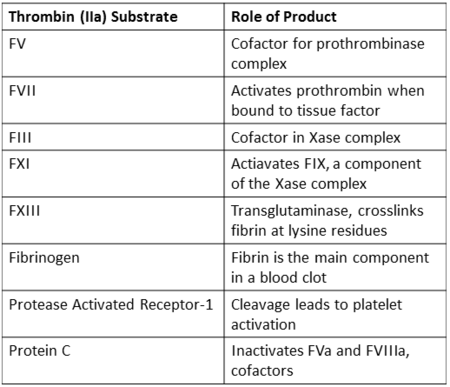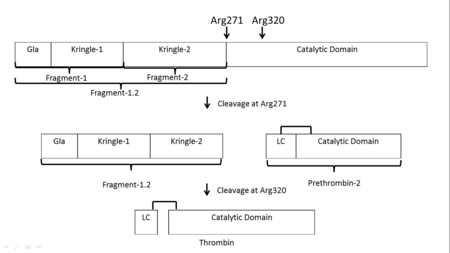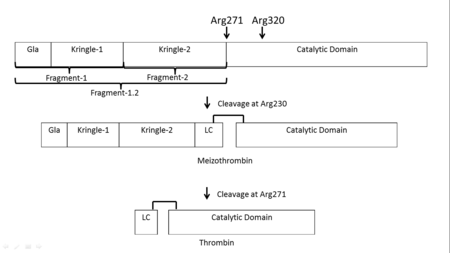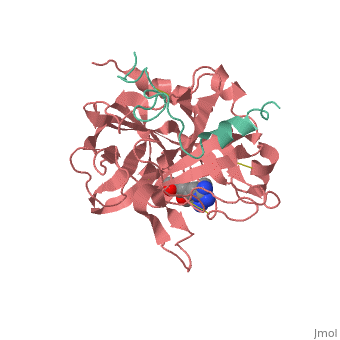Thrombin
From Proteopedia
IntroductionThrombin (Thr) is a serine protease. Prothrombin (PThr) is cleaved by prothrombinase at 2 cleavage sites to form the 2 chains of Thr in the coagulation cascade[1]. The first step of the cleavage is at residue R320 and produces meizothrombin (MThr)[2]. Thr catalyzes the conversion of fibrinogen to the insoluble fibrin. Thr is composed of heavy chain (HC) and light chain (LC). Prethrombin-1 lacks 155 N-terminal residues of PThr and is composed of a single polypeptide chain. Prethrombin-2 is the product of proteolysis of prethrombin-1 by trypsin or by active factor X. P-PACK Thr is a chemically modified Thr with inactivated catalytic site and active anion binding site. Hirudin is the most potent natural inhibitor of Thr (Sean Swale/Human Thrombin Inhibitor). For some more details see Serine Proteases. Prothrombin cleavage results in the creation of thrombin, a coagulative agent in plasma and is connected to fibrinolysis and platelet activation. During this process several peptides involved in the conversion are released into the plasma, and the remaining protein splits into two portions(http://www.uniprot.org/citations/3759958). It has been shown that prothrombin has a statistically significant connection to the occurrence of ischemic stroke with the presence of the G20210A mutation, though the cause was not isolated to prothrombin alone (http://www.uniprot.org/citations/15534175) (these links added by Connor Gramazio). Some additional details in
Thrombin catalyzes the penultimate step in blood coagulation. It is activated from its zymogen, prothrombin, at the site of tissue injury by Factor Xa (FXa) and its cofactor FVa in the presence of phospholipid membrane and calcium. Thrombin is then able to catalyze the cleavage of fibrinogen to insoluble fibrin which spontaneously polymerizes to form a stable clot.[3][4] Thrombin also acts as a procoagulant by:
Activity of thrombin is regulated physiologically by the serpin inhibitors:
Generation of thrombin is decreased when thrombin reaches endothelial lining and interacts with thrombomodulin which significantly increases activity of thrombin in activating protein C (PC -> APC).[11] This enzyme will go on to inactivate FVa[12][13] and FVIIIa[13] , cofactors for activation of prothrombin[14] and FXa[15], respectively. By balancing substrate specificity, activity, and inhibition thrombin plays a central role in the blood coagulation cascade. [6] The Thrombin Life CycleUpon tissue damage tissue factor (TF) is released by subendothelial cells. This interacts with circulating FVIIa, a zymogen-like serine protease, significantly increasing its activity. The FVIIa-TF complex (extrinsic Xase) activates FVII, FIX, and FX. The now active FXa cleaves prothrombin bound to membranes through its gamma-carboxyglutamyl (Gla) domain, activating it to thrombin. Thrombin interacts with platelet membrane protein GpIbα and subsequently cleaves protease activated receptor-1 (PAR1) causing a signaling cascade which leads to platelet α-granule release and membrane flipping exposing the negatively charged phosphatidylserine. The platelet alpha granules contain the physiologically relevant pool of FVa. [16] Thrombin also causes activation of FIX, through FXI cleavage, and FVIII which form the Xase complex to activate FX. FVa and FXa form the prothrombinase complex in the presence of calcium and phospholipid. It causes rapid activation of prothrombin to thrombin. This increase in thrombin allows sufficient fibrinogen to be cleaved to fibrin which is able to polymerize to form a stable blood clot. Further supporting coagulation, thrombin activates FXIII, a transglutaminase that crosslinks fibrin at lysine residues. The structure of thrombin facilitates its inactivation. Once the endothelial lining is reached thrombin binds heparin or related glycosaminoglycans. This facilitates its inactivation by serpin inhibitors antithrombin and heparin cofactor II. In addition, thrombin will interact with thrombomodulin which significantly increases its catalytic efficiency activating protein C. Activated protein C inactivates FVIIa and FVa thus down regulating thrombin generation.
Thrombin plays a critical dual role in blood coagulation. It must be both promiscuous and specific so that it may complete both procoagulant and anticoagulant functions. The structure of thrombin facilitates its important physiologic functions. Prothrombin ActivationProthrombin is the zymogen form of thrombin. From N-terminal to C-terminal it consists of a Gla domain, two kringle domains, and a catalytic domain. The Gla domain is formed by vitamin K dependent carboxylation of glutamate residues.[17] Prothrombin is activated by prothrombinase which consists of FXa, FVa, calcium, and a phospholipid surface. In vivo the first cleavage occurs at the R320-I321 bond, corresponding to residues 15-16 in chymotrypsin which is the N-terminus of the B chain, producing meizothrombin.[18] Subsequent cleavage at R271-T272 yields thrombin.[18] The initial cleavage can also occur at R271 resulting in prethrombin-2 which will then be cleaved at R320 to produce thrombin.[19] After cleavage by prothrombinase the new B chain N-terminus (Ile16) folds into the core protease domain and forms a salt bridge with Asp194.[18] This leads to stabilization of regions of the 180s-loop, Na+ binding loop, and γ-loop (zymogen activation domains). These changes provide the correct conformation for the S1 pocket and oxyanion hole for catalysis.[18][20]
Structure and FunctionThrombin is a α/β heterodimer composed of a 36 amino acid A chain and 259 amino acid B chain connected by a disufide bridge between Cys1 and Cys122, in addition to 3 other intrachain disulfide bonds.[21] Its overall fold is similar to trypsin and chymotrypsin and it belongs to the peptidase S1 protease family[22]. It is an overall spherical protein with approximate dimensions of 45 Å X 45 Å X 50 Å.[21] Important structural features include:
The A chain is mostly helical and is wound around the B chain and shaped like a boomerang. It is bound to the B chain mostly through side chain interactions including a salt bridge and a hydrogen bond cluster at residues D14, E8, and E14c.[21] Furthermore the C-terminus region forms a short amphipathic helix with hydrophobic side chains interacting with the B chain.[21] The B chain contains the active site of the protein and has numerous notable structural features. The active site is formed at the rims of two interacting 6 stranded beta barrel domains(N-terminal barrel in red and C-terminal barrel in orange) which are surrounded by 4 helical regions and many turns. The serine protease catalytic triad (wiki) residues, based on chymotrypsin numbering, are Ser195, His57, and Asp102. As is common with serine proteases, an oxyanion hole hole is formed by backbone amides of Ser195 and Gly193.[18] This has the functional role of stabilizing the oxyanion intermediate involved in the serine protease mechanism by hydrogen bonding to the oxygen of the P1 residue (standard substrate-protease nomeclature [23]. In addition, since thrombin cleaves after Arg/Lys the S1 specificity site, formed by the 180s- and 220s- loops, has Asp189 at the base to form a salt bridge with the incoming substrate. Furthermore, the S4 binding pocket accommodates hydrophobic substrate residues. The active site cleft rims are formed by the hydrophobic and rigid 60-loop (residues L60, Y60a, P60b, P60c, W60d, D60e, K60f, N60g, F60h, T60i, and N60g) and the γ-loop (residues T147, W147a, T147b, A147c, N147d, and V147f) while the base is mostly hydrophilic negatively charged amino acids. The cleft is deep compared to more promiscuous serine proteases, consequently substrates must either have a large loop that is cleaved or have favorable interactions with the insertion loops [24]. Many other loops project out of the B chain but most are rigid due to proline and tryptophan residues. Exosite I is located on the B chain and had both basic and hydrophobic character. It is important in binding fibrinogen, platelet activated receptors, and thrombomodulin. Exosite II is also part of the B chain, and derived from numerous basic amino acids, this is the site of heparin binding through the sulfate groups on the glycosaminoglycan. It is also the site of GpIbα binding on the platelet surface. The sodium binding site is formed by the 180s- and 220s- loops. Na+ is bound by the backbone oxygens of Arg221a and Lys224 in addition to four water molecules in a classic octahedral geometry[25]. Through the covelent disulfide linkage between Cys220 and Cys 191 the sodium binding site is linked to Ser195 and the oxyanion hole. Thrombin is a "trypsin-like" serine protease. Its structure (PDB code 1ppb) is shown here with a peptide chloroketone inhibitor (PPACK). The thrombin A chain (cleaved N terminal fragement) is shown in cyan and the B chain is shown in red. The Active site is made up of a catalytic triad of Ser195, His57 and Asp102, backed up by Ser214. The peptide chloroketone inhibitor (PPACK) is shown in purple. A closeup shows the activation site at which the sidechain of Asp194 makes a salt link with the N-terminus at residue 16, newly formed when the A chain is cleaved in the zymogen-to-enzyme activation process. The specificity pocket is on one side of the throat of the domain 2 beta barrel, and the activation site is close next to it. The B chain consists of two domains. As is true for all of the "trypsin-like" serine proteases, each of the two thrombin domains consists mainly of a 6-stranded, antiparallel beta barrel. The specificity pocket (here filled with the Lys sidechain of the PPACK inhibitor) is in one side of the throat of the domain 2beta barrel, and the activation site is close next to it.
AllosteryBinding of thrombin by sodium or at exosite I stabilizes a form of thrombin that improves substrate recognition.[18] This occurs due to energetic linkage between these sites to the S1 binding pocket and oxyanion hole. Rapid kinetic analysis suggests that thrombin is in a dynamic equilibrium that consists of a fast, slow, and inactive state[18]. There is question as to the physiologic relevance of the inactive state. Regardless, there will be a proportion of fast:slow thrombin and sodium binding to the fast form stabilizes that conformation. Indeed, mutation of the residues involved in sodium binding diminishes the activity of thrombin.[18] It should be restated, current data suggest that sodium binding does not induce a conformation change, rather, it stabilizes a conformation of thrombin that has greater activity. Regulation and InhibitionThrombin is regulated by inhibition and down regulation of production.
Antithrombin and heparin cofactor II are serpin inhibitors of thrombin that bind to specific sequences of sugar residues within a heparin chain on the endothelial lining.[26] Thrombin also interacts with heparin nonspecific to sequence through its exosite II.[10] Thus, heparin acts as a surface that is outside of the procoagulant environment of the blood clot for thrombin interaction with inhibitors.
Thrombomodulin also binds to heparin (through an EGF-like domain) and thombin, it causes a conformation in thrombin that increases activity for TAFI and protein C by 1000-fold.[27] APC then inactivates FVa and FVIIIa effectively decreasing the concentration of prothrombinase and Xase respectively, and thereby down regulating thrombin production.
Central to both of these regulation pathways are specific cofactor binding at thrombins exosites; thrombomodulin and antithrombin at exosite I and heparin at exosite II. Therefore the structure of thrombin uniquely provides it the functional properties necessary for regulation.
Secondary Structure FeaturesThrombin has a cis peptide bond in a loop containing proline 37. The dihedral (C'-Cα-N-C') angle omega is -69.4 degrees. 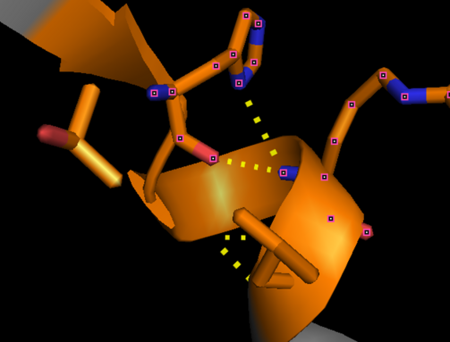 “Capping box” motif in alpha thrombin (PDB: 1PPB) represented by His230 (Ncap) side chain and main chain hydrogen bonded with the backbone nitrogen of Arg233 (N3). An additional feature is a weak hydrophobic interaction between Thr229 (N’) and Val234 (N4) termed the “hydrophobic staple.” This motif derives it’s name from the box shaped hydrogen bonding pattern. 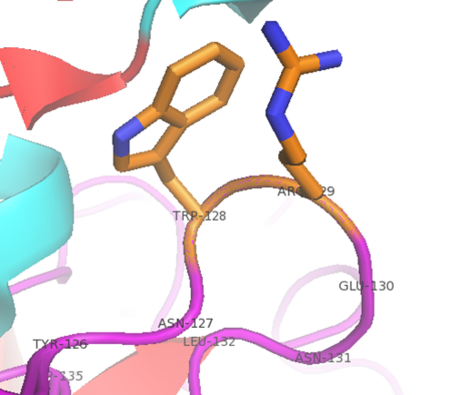 A cation-π interaction between Trp128 and Arg 129 in alpha thrombin (PDB: 2BDY). The guanidinium carbon is 3.6 angstroms from the top edge of the Trp. It is expected that the epsilon nitrogen forms the primary cation-π interaction. The electrostatic and Van der Waals interaction energies were calculated to be -3.29 kcal/mol and -3.08 kcal/mol respectively by the CaPTURE program (http://capture.caltech.edu/result.cgi). 3D Structures of thrombin
|
| |||||||||||
References
- ↑ Krishnaswamy S. The transition of prothrombin to thrombin. J Thromb Haemost. 2013 Jun;11 Suppl 1(0 1):265-76. PMID:23809130 doi:10.1111/jth.12217
- ↑ Bradford HN, Krishnaswamy S. Meizothrombin is an unexpectedly zymogen-like variant of thrombin. J Biol Chem. 2012 Aug 31;287(36):30414-25. PMID:22815477 doi:10.1074/jbc.M112.394809
- ↑ Fenton JW 2nd. Thrombin specificity. Ann N Y Acad Sci. 1981;370:468-95. PMID:7023326
- ↑ 4.0 4.1 Coughlin SR. Thrombin signalling and protease-activated receptors. Nature. 2000 Sep 14;407(6801):258-64. PMID:11001069 doi:http://dx.doi.org/10.1038/35025229
- ↑ Crawley JT, Lam JK, Rance JB, Mollica LR, O'Donnell JS, Lane DA. Proteolytic inactivation of ADAMTS13 by thrombin and plasmin. Blood. 2005 Feb 1;105(3):1085-93. Epub 2004 Sep 23. PMID:15388580 doi:http://dx.doi.org/10.1182/blood-2004-03-1101
- ↑ 6.0 6.1 6.2 6.3 6.4 6.5 6.6 Lane DA, Philippou H, Huntington JA. Directing thrombin. Blood. 2005 Oct 15;106(8):2605-12. Epub 2005 Jun 30. PMID:15994286 doi:http://dx.doi.org/10.1182/blood-2005-04-1710
- ↑ Takagi T, Doolittle RF. Amino acid sequence studies on factor XIII and the peptide released during its activation by thrombin. Biochemistry. 1974 Feb 12;13(4):750-6. PMID:4811064
- ↑ Miljic P, Heylen E, Willemse J, Djordjevic V, Radojkovic D, Colovic M, Elezovic I, Hendriks D. Thrombin activatable fibrinolysis inhibitor (TAFI): a molecular link between coagulation and fibrinolysis. Srp Arh Celok Lek. 2010 Jan;138 Suppl 1:74-8. PMID:20229688
- ↑ 9.0 9.1 9.2 9.3 Huntington JA. Natural inhibitors of thrombin. Thromb Haemost. 2014 Apr 1;111(4):583-9. doi: 10.1160/TH13-10-0811. Epub 2014 Jan, 30. PMID:24477356 doi:http://dx.doi.org/10.1160/TH13-10-0811
- ↑ 10.0 10.1 10.2 10.3 10.4 Huntington JA. Thrombin inhibition by the serpins. J Thromb Haemost. 2013 Jun;11 Suppl 1:254-64. doi: 10.1111/jth.12252. PMID:23809129 doi:http://dx.doi.org/10.1111/jth.12252
- ↑ Esmon CT. The regulation of natural anticoagulant pathways. Science. 1987 Mar 13;235(4794):1348-52. PMID:3029867
- ↑ Kalafatis M, Rand MD, Mann KG. The mechanism of inactivation of human factor V and human factor Va by activated protein C. J Biol Chem. 1994 Dec 16;269(50):31869-80. PMID:7989361
- ↑ 13.0 13.1 Lu D, Kalafatis M, Mann KG, Long GL. Comparison of activated protein C/protein S-mediated inactivation of human factor VIII and factor V. Blood. 1996 Jun 1;87(11):4708-17. PMID:8639840
- ↑ Duga S, Asselta R, Tenchini ML. Coagulation factor V. Int J Biochem Cell Biol. 2004 Aug;36(8):1393-9. PMID:15147718 doi:http://dx.doi.org/10.1016/j.biocel.2003.08.002
- ↑ Saenko EL, Shima M, Sarafanov AG. Role of activation of the coagulation factor VIII in interaction with vWf, phospholipid, and functioning within the factor Xase complex. Trends Cardiovasc Med. 1999 Oct;9(7):185-92. PMID:10881749
- ↑ Camire, R. M. (2010). Platelet factor V to the rescue. Blood, 115(4), 753-754. DOI: 10.1182/blood-2009-11-252619
- ↑ Berkner KL. Vitamin K-dependent carboxylation. Vitam Horm. 2008;78:131-56. doi: 10.1016/S0083-6729(07)00007-6. PMID:18374193 doi:http://dx.doi.org/10.1016/S0083-6729(07)00007-6
- ↑ 18.0 18.1 18.2 18.3 18.4 18.5 18.6 18.7 Lechtenberg BC, Freund SM, Huntington JA. An ensemble view of thrombin allostery. Biol Chem. 2012 Sep;393(9):889-98. doi: 10.1515/hsz-2012-0178. PMID:22944689 doi:http://dx.doi.org/10.1515/hsz-2012-0178
- ↑ Tijburg PN, van Heerde WL, Leenhouts HM, Hessing M, Bouma BN, de Groot PG. Formation of meizothrombin as intermediate in factor Xa-catalyzed prothrombin activation on endothelial cells. The influence of thrombin on the reaction mechanism. J Biol Chem. 1991 Feb 25;266(6):4017-22. PMID:1995649
- ↑ Bobofchak KM, Pineda AO, Mathews FS, Di Cera E. Energetic and structural consequences of perturbing Gly-193 in the oxyanion hole of serine proteases. J Biol Chem. 2005 Jul 8;280(27):25644-50. Epub 2005 May 12. PMID:15890651 doi:http://dx.doi.org/10.1074/jbc.M503499200
- ↑ 21.0 21.1 21.2 21.3 Bode W, Mayr I, Baumann U, Huber R, Stone SR, Hofsteenge J. The refined 1.9 A crystal structure of human alpha-thrombin: interaction with D-Phe-Pro-Arg chloromethylketone and significance of the Tyr-Pro-Pro-Trp insertion segment. EMBO J. 1989 Nov;8(11):3467-75. PMID:2583108
- ↑ Page MJ, Di Cera E. Evolution of peptidase diversity. J Biol Chem. 2008 Oct 31;283(44):30010-4. doi: 10.1074/jbc.M804650200. Epub 2008 , Sep 3. PMID:18768474 doi:http://dx.doi.org/10.1074/jbc.M804650200
- ↑ Schechter I, Berger A. On the size of the active site in proteases. I. Papain. 1967. Biochem Biophys Res Commun. 2012 Aug 31;425(3):497-502. doi:, 10.1016/j.bbrc.2012.08.015. PMID:22925665 doi:http://dx.doi.org/10.1016/j.bbrc.2012.08.015
- ↑ Huntington JA. Molecular recognition mechanisms of thrombin. J Thromb Haemost. 2005 Aug;3(8):1861-72. PMID:16102053 doi:http://dx.doi.org/10.1111/j.1538-7836.2005.01363.x
- ↑ Zhang E, Tulinsky A. The molecular environment of the Na+ binding site of thrombin. Biophys Chem. 1997 Jan 31;63(2-3):185-200. PMID:9108691
- ↑ Li W, Johnson DJ, Esmon CT, Huntington JA. Structure of the antithrombin-thrombin-heparin ternary complex reveals the antithrombotic mechanism of heparin. Nat Struct Mol Biol. 2004 Sep;11(9):857-62. Epub 2004 Aug 15. PMID:15311269 doi:10.1038/nsmb811
- ↑ Spronk HM, Borissoff JI, ten Cate H. New insights into modulation of thrombin formation. Curr Atheroscler Rep. 2013 Nov;15(11):363. doi: 10.1007/s11883-013-0363-3. PMID:24026641 doi:http://dx.doi.org/10.1007/s11883-013-0363-3
With participation by User:Cody Couperus
Proteopedia Page Contributors and Editors (what is this?)
Michal Harel, Alexander Berchansky, Cody Couperus, Joel L. Sussman
